Think about a world the place each interplay between a model and its viewers shouldn’t be merely a touchpoint however a real connection — a second that feels private, participating, and related.
That is the place influencer advertising is heading, pushed by a strong shift in direction of authenticity, expertise, and data-driven methods.
Within the October 2024 Influencer Advertising Report (primarily based on 247 surveyed entrepreneurs), we witnessed a profound transformation unfolding throughout the digital panorama. We’re not merely observing developments however witnessing the disruption of typical advertising norms, guided by the preferences of Gen Z entrepreneurs and the mixing of expertise like AI.
The query for manufacturers and entrepreneurs is not about whether or not to make use of influencers however about tips on how to forge deeper, extra genuine relationships that minimize via the noise of an more and more saturated market. That is the second the place thought leaders and Key Opinion Leaders (KOLs) within the B2B sector particularly emerge because the driving power behind these modifications, shifting the main target from follower counts to real influence and belief.
Key Findings from our October Report
How “Biden and Trump” Faculty Us All on Influencer Advertising
Gary Vaynerchuk not too long ago pointed out on nationwide TV that
“Washington is typically forward of Madison Avenue. I feel the actual punchline is that Fortune 500 firms are grossly under-investing in influencer advertising.”
Think about the stakes: probably the most vital political campaigns in historical past, the place successful or shedding may reshape whole nations, hinge not on conventional media buys or mass-market adverts however on the power to create genuine connections via influencers.
The continuing presidential campaigns have underscored a captivating actuality: influencers should not only a device within the advertising toolkit; they’re the game-changers. The affect methods of Kamala Harris, Donald Trump, and Joe Biden should not merely attention-grabbing case research; they’re a blueprint for the way forward for advertising. This shift has left Fortune 500 firms scrambling, as political campaigns have proven them what it really means to be modern within the digital age.
The unsettling irony right here is that whereas company giants are sometimes heralded because the bastions of innovation, it’s political campaigns — entities not usually identified for agility or trendsetting — which have mastered the artwork of influencer advertising. They’ve seamlessly built-in influencers into their communication methods, leveraging them not only for visibility however for authenticity, engagement, and actual affect over public opinion.
4.3 Million Views, 300K Downloads, and a 31.88% Conversion Price
So, whereas Gary V could be shaking his head at how underutilized influencer advertising is within the company world, NeoReach simply quietly schooled everybody on the way it’s completed.
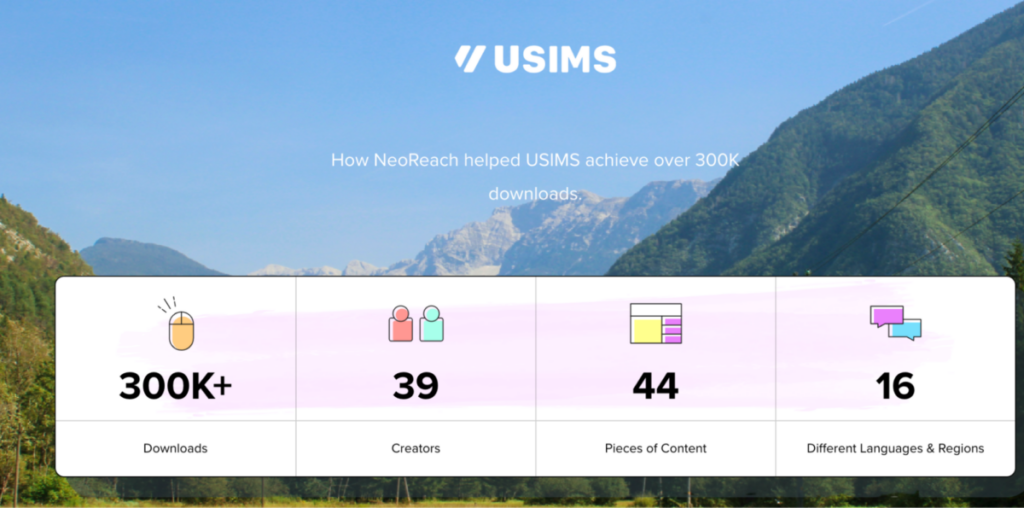
When USIMS, a contemporary contender within the eSIM market, discovered themselves squaring off towards giants like Verizon and T-Cellular, they knew they couldn’t simply dabble within the influencer sport—they needed to rewrite the rulebook.
USIMS wanted greater than visibility—they wanted to personal the dialog in a market saturated by business titans. Their objectives had been formidable:
- Go World: Enter 16+ new markets and make USIMS a family title
- Scale Income: Convert these downloads into long-term, engaged prospects
NeoReach’s Magic Method
NeoReach went past the fundamentals, crafting a multi-layered influencer technique that introduced precision and scale to the desk. Right here’s how they turned a frightening problem right into a roaring success:
1. “At all times-On” Influencer Activation: NeoReach activated 39 creators throughout 16 completely different languages and areas to advertise USIMS.
2. Leveraging Macro Moments: NeoReach seized on international occasions just like the Paris Olympics to create memorable content material moments.
3. Mixing Creativity with Information-Pushed Precision: NeoReach didn’t simply depend on intestine intuition; they built-in web optimization, ASO (App Retailer Optimization), and paid media methods to gasoline influencer content material distribution.
4. Platform-Particular Ways: Understanding that each platform performs a special position, NeoReach strategically onboarded influencers throughout Instagram, TikTok, and YouTube.
The Outcomes?
NeoReach’s holistic technique didn’t simply meet the KPIs—it smashed them. The marketing campaign’s success was pushed by a mix of genuine influencer storytelling, information optimization, and exact concentrating on that created a seamless synergy throughout digital channels.
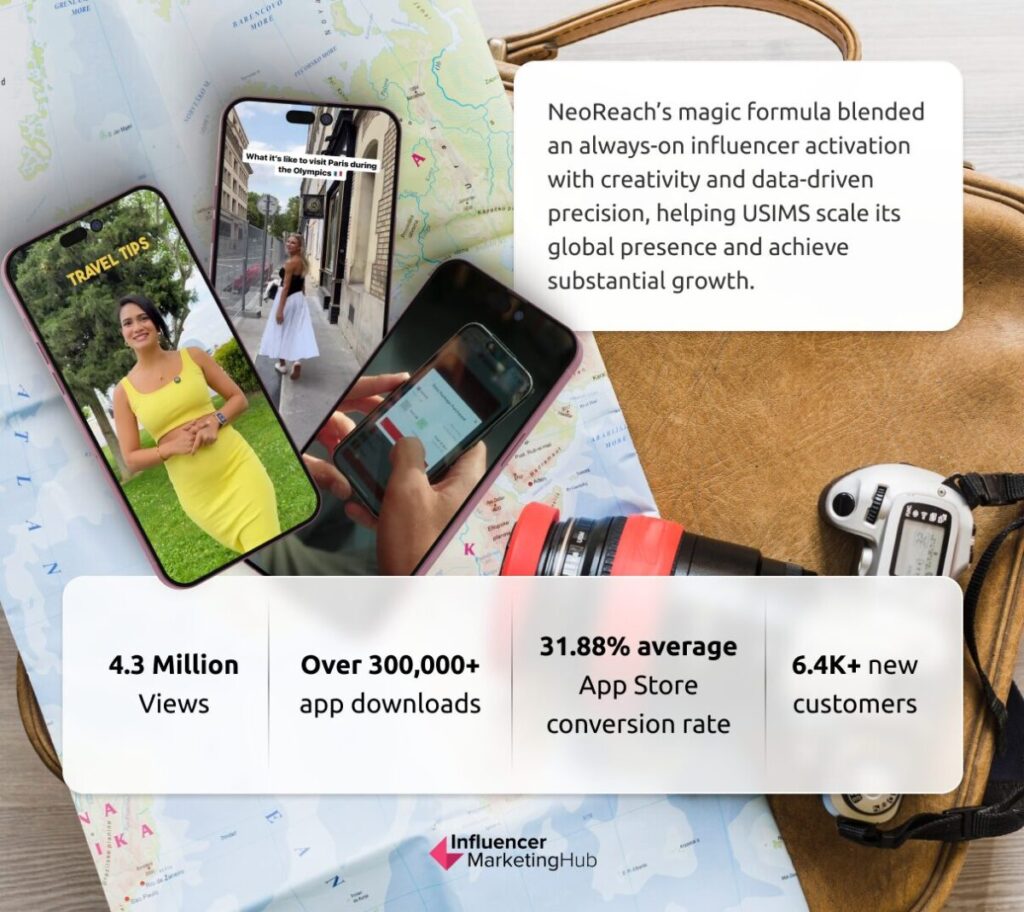
- 4.3 Million Views
- Over 300,000+ app downloads
- A 31.88% common App Retailer conversion fee
- 6.4K+ new prospects
NeoReach’s marketing campaign wasn’t only a win for USIMS; it was a masterclass in influencer advertising completed proper. They proved that it’s not concerning the largest budgets or the flashiest influencers—it’s about good concentrating on, real storytelling, and leveraging influencers who can really transfer the needle.
Learn the complete case research right here.
From Tremendous Influencers to Nano-Influencers and Thought Leaders
The October 2024 report highlights a strategic pivot in direction of nano-influencers and area of interest creators, emphasizing their authenticity and deep connections with extremely engaged audiences. In comparison with our findings from July, the desire for nano-influencers has grown considerably, with 53.4% of entrepreneurs now contemplating them more practical—a notable improve from the 43% who indicated an analogous desire just some months earlier. This upward development suggests a deepening appreciation for the qualitative points of affect, the place belief, relevance, and engagement take priority over sheer follower counts.
Within the B2B advertising panorama, the rise of thought leaders and Key Opinion Leaders (KOLs) continues to reshape how manufacturers construct credibility and drive business conversations. Whereas July’s information already pointed to the significance of those influential voices, the momentum has solely intensified. With 82% of B2B consumers conducting on-line analysis earlier than participating with a model, these thought leaders have change into much more crucial, transferring past mere model amplification to form decision-making processes and set up authority of their respective fields.
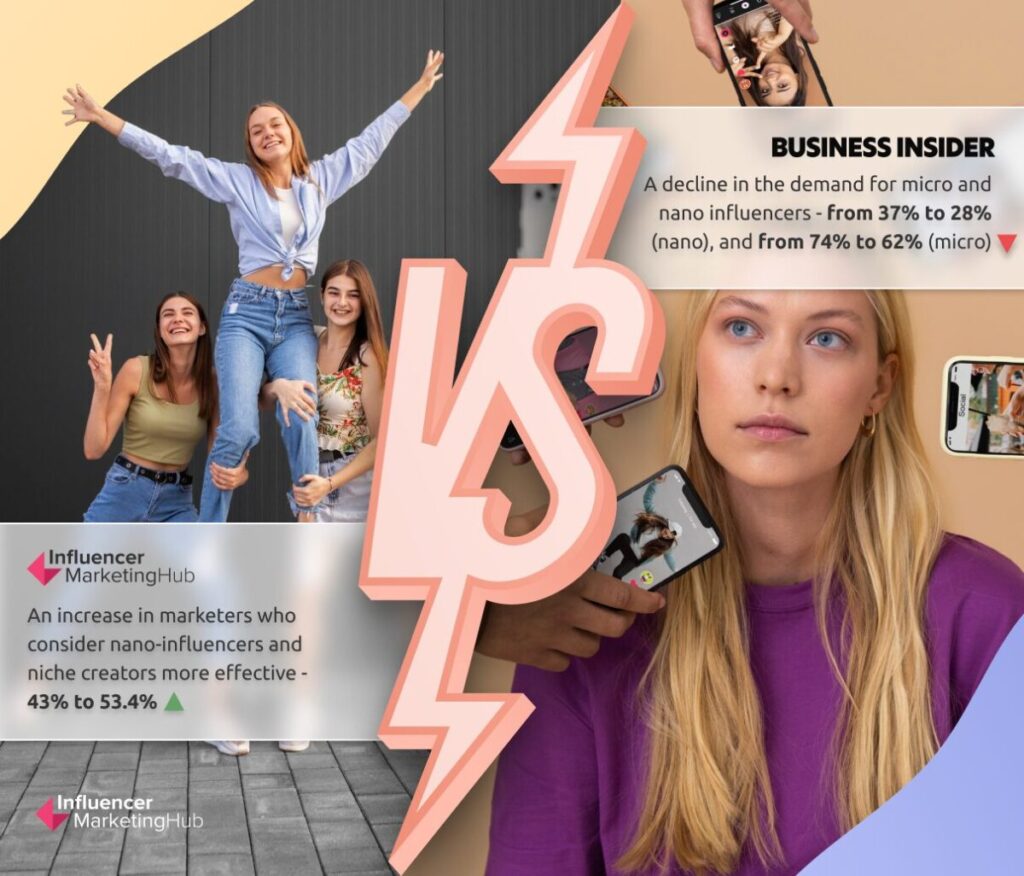
Nonetheless, the latest Enterprise Insider findings inform a special story, one which appears to diverge from the rising developments we noticed. Their report suggests a swing again to macro and mega influencers, pushed by elevated curiosity in movie star partnerships. Based on their survey, the share of entrepreneurs planning to work with movie star influencers elevated from 30% to 40% between 2023 and 2024, whereas curiosity in mega influencers rose from 48% to 60% over the identical interval. In the meantime, the demand for micro and nano influencers reportedly declined, with nano-influencer engagement dropping from 37% to twenty-eight% and micro influencers from 74% to 62%.
Whereas these statistics paint an image of entrepreneurs gravitating in direction of greater names, we problem the underlying assumptions on this evaluation. Enterprise Insider’s findings appear narrowly targeted on cost-related considerations, highlighting that micro-influencer charges have elevated by as much as 20%, main manufacturers to go for bigger influencers. But, they largely overlook a crucial issue: Return on Funding (ROI). In influencer advertising, the price of engagement is just a part of the equation; the power to drive conversions, construct belief, and set up long-term relationships usually delivers probably the most vital worth. By inserting heavy emphasis on “attain” and speedy visibility, their strategy neglects the deeper influence that nano and micro influencers can have on constructing real connections with audiences.
Information is the New Gold in Influencer Advertising
As we speak, we as shoppers have a low tolerance for fluff — they crave data-backed insights and techniques that ship tangible outcomes, particularly as Entrepreneurs. And let’s be actual, if there’s one entity that proved the facility of knowledge in influencer advertising, it was Cambridge Analytica. Like it or hate it, they didn’t simply dip their toes within the influencer sport; they cannonballed into the pool and altered the principles for everybody. With their controversial use of knowledge to micro-target tens of millions of voters, they confirmed us that whenever you maintain the proper playing cards—which means, the info—you possibly can affect the lots with a precision that the majority manufacturers nonetheless battle to grasp.


Supply: bbc.com
The October report reveals that manufacturers at this time are more and more integrating AI and sentiment evaluation to refine their influencer campaigns, signaling a shift in direction of extra exact, data-driven decision-making. Nonetheless, this reliance on AI is not with out its challenges, significantly round sustaining the human contact in influencer-driven interactions.
AI’s potential lies in its capacity to streamline operations, determine developments, and optimize content material creation. But, as we discovered from Cambridge Analytica, the actual game-changer isn’t just within the capacity to course of information, however in realizing tips on how to wield it. The problem, nevertheless, is to steadiness this technological development with authenticity. Our October survey information signifies that 54.8% of entrepreneurs view AI favorably for enhancing effectivity.
The Cambridge Analytica case ought to function a lesson for all entrepreneurs: Information is gold, however the best way you employ it’s what really defines your success. Whereas AI and machine studying provide new avenues for understanding viewers habits and customizing content material to their wants, the actual artwork lies in making that data-driven strategy really feel human, relatable, and reliable. As a result of on the finish of the day, it’s not nearly reaching folks—it’s about connecting with them in ways in which matter.

Influencer Fatigue: Redefining Engagement in a Saturated Panorama
One of the thought-provoking revelations from the October survey is the rising phenomenon of influencer fatigue. With 52.1% of entrepreneurs acknowledging an increase in influencer fatigue, significantly in direction of mega-influencers, it is clear that the business is approaching a crucial inflection level. Shoppers, bombarded by branded messages and repetitive content material, have gotten extra selective about who they belief and have interaction with.

To counter this, manufacturers are pivoting in direction of micro and nano-influencers, whose content material usually feels extra real and relatable. This shift is greater than only a tactical response; it’s a strategic recalibration that aligns with the evolving shopper desire for relatability and relevance. Entrepreneurs who prioritize these smaller, extra engaged communities should not solely future-proofing their methods but additionally laying the groundwork for extra sustainable and impactful influencer relationships.
Whereas our survey reveals considerations about influencer fatigue on the macro degree, an article not too long ago revealed by Jaxon Parrott highlights that influencer advertising stays one of the efficient instruments in combating advert fatigue in particular sectors. The important thing distinction lies in how manufacturers are deploying these methods. In areas like cybersecurity, the main target is on trusted voices and influencers with area of interest experience, moderately than purely on attain or follower counts.
As we speak, greater than ever within the B2B area, it is about connecting manufacturers with business specialists who can sway key decision-makers like CTOs and CMOs at Fortune 500 firms. Think about the influencer you respect most on LinkedIn constantly endorsing a software program resolution tailor-made to your business—how rather more would that resonate than a normal advert?
These platforms are transferring in direction of high-trust, native placements that mix seamlessly into skilled content material, making suggestions really feel much less like a gross sales pitch and extra like real recommendation. It’s a game-changer within the influencer panorama, turning advertising into an genuine dialog that builds actual credibility with those that matter most.
The Evolution of B2B Influencer Advertising: Thought Leaders and KOLs Lead the Cost
Neglect the old-school strategy of chasing large names with enormous followings; the actual game-changer in B2B influencer advertising is about discovering those that can genuinely form business conversations—thought leaders and Key Opinion Leaders (KOLs) with deep experience. The truth is, 87% of B2B consumers say they belief content material from these business specialists over brand-produced supplies. And that’s no small element; it’s a transparent sign that manufacturers have to concentrate on those that really affect decision-making.
Let’s discuss how IBM and Microsoft should not simply driving the influencer advertising wave; they’re creating it. These tech giants have mastered the artwork of mixing inner influencers (their very own staff) with exterior thought leaders to construct credibility and belief.
- IBM’s Influencer Insights Program: IBM isn’t simply in search of exterior voices; they’re turning their very own crew into influencers. By means of coaching and structured packages, IBM’s inner specialists are actively sharing their data on platforms like LinkedIn, positioning themselves as trusted advisors throughout the tech business. They’ve additionally partnered with thought leaders like Daniel Newman to generate content material on AI and digital transformation, boosting their affect and credibility.
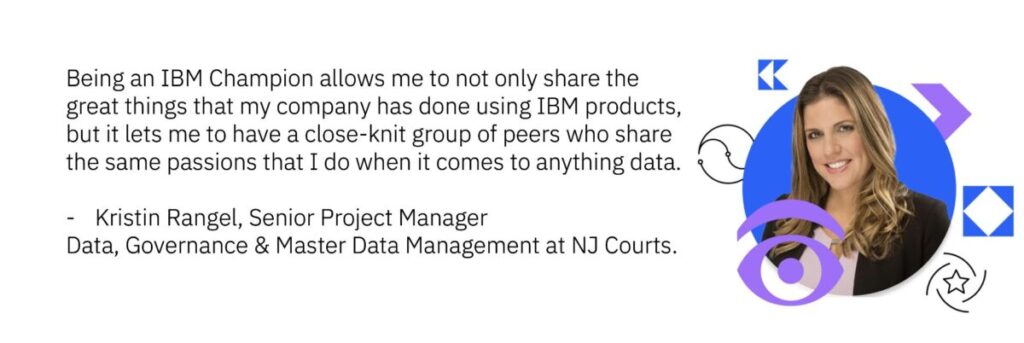

Supply: linkedin.com
- Motivation and Engagement Methods at IBM: What units IBM aside is how they create a tradition of affect amongst their staff. They incentivize participation via recognition programs, just like the “IBM Influencer” badge, motivating staff to share their experience and contribute to business discussions. This not solely amplifies their attain but additionally solidifies IBM’s authority as a thought chief, with out at all times counting on exterior voices.
- Microsoft’s MVP Program: Microsoft’s strategy is all about co-creating with their neighborhood. The MVP Program faucets right into a community of tech specialists who aren’t simply influencers; they’re co-creators in product growth. These influencers assist Microsoft by sharing suggestions, creating early product content material, and internet hosting academic webinars that resonate deeply with the tech neighborhood. This technique not solely drives product adoption but additionally positions Microsoft because the go-to title in AI and cloud improvements. The info speaks for itself—this collaborative technique has considerably boosted Microsoft’s business affect and neighborhood engagement.
Right here’s the fact: B2B manufacturers want to maneuver past the outdated ways of broad visibility and as an alternative concentrate on credibility. Think about seeing your most-followed LinkedIn skilled constantly endorsing an answer tailor-made to your business—it’s greater than an commercial; it’s a strong validation that shapes perceptions.
This concentrate on belief is supported by the truth that 81% of decision-makers belief peer suggestions over any type of promoting. Manufacturers like SAP have leveraged this perception by collaborating with influencers on thought management content material like AI whitepapers, resulting in a 400% improve in lead conversions from these focused efforts. This instance demonstrates the tangible influence of utilizing influencers to co-create high-value content material that resonates with B2B decision-makers.
Managing Sentiment: Turning Criticism into Progress Alternatives
One other focus of the October report is the proactive strategy manufacturers are taking to handle destructive sentiment of their campaigns. With practically 47.9% of entrepreneurs actively participating with audiences to resolve points and 31.8% rising transparency about marketing campaign processes, it’s clear that authenticity and belief are on the forefront of recent influencer methods. This transparency is crucial in turning potential backlash into alternatives for development and deeper engagement.
Manufacturers that efficiently navigate this terrain perceive that transparency shouldn’t be a buzzword however a strategic device for constructing long-term relationships. By addressing considerations brazenly and adapting their content material technique primarily based on suggestions, they will flip critics into advocates and foster loyalty in an more and more skeptical viewers.
The Integration of Shoppable Content material: Changing Engagement into Income
The rise of shoppable content material codecs is one other key development, reworking how manufacturers work together with shoppers and drive conversions. With 45.3% of entrepreneurs frequently utilizing shoppable content material codecs and 52.9% seeing elevated conversion charges consequently, the seamless integration of e-commerce into social media platforms is revolutionizing the shopper journey.
Shoppable content material reduces friction within the buying course of, making a extra intuitive buying expertise instantly from the influencer’s content material. This strategy not solely enhances consumer expertise but additionally gives manufacturers with beneficial information to refine their methods and enhance ROI. The way forward for influencer advertising will undoubtedly see extra manufacturers embracing these codecs to attach with audiences in a means that’s each participating and transactional.
October Developments in Influencer Advertising: A Information-Pushed Evaluation
(First Get together Information by Influencer Advertising Hub Month-to-month Survey)
Because the influencer advertising panorama continues to evolve, pushed by expertise, information insights, and shifting shopper preferences, our October 2024 survey of 247 entrepreneurs presents an in depth snapshot of present business developments. This report goes past surface-level observations, diving deep into the newest shifts in influencer advertising methods and offering an in-depth evaluation of the survey outcomes. By evaluating these insights with information from July 2024, we determine rising patterns, spotlight key developments, and description actionable methods that may assist manufacturers and entrepreneurs keep forward on this ever-changing panorama.
Allocation of Advertising Finances to Influencer Advertising
Understanding finances allocation is essential in figuring out the strategic priorities of entrepreneurs. Based on the October 2024 survey, finances distribution stays diversified, reflecting various ranges of dedication to influencer advertising. The breakdown of finances allocation is as follows:
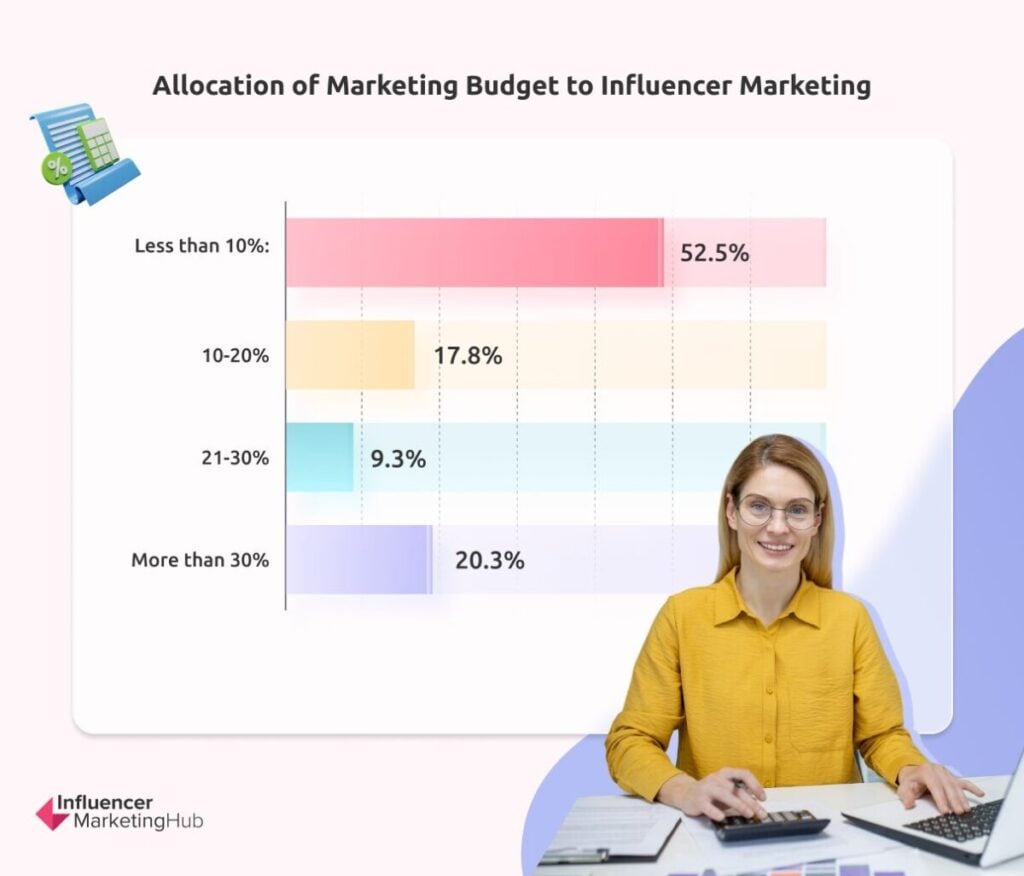
- Lower than 10%: 52.5%
- 10-20%: 17.8%
- 21-30%: 9.3%
- Greater than 30%: 20.3%
Comparative Evaluation with July Information
In July, the distribution of finances allocations confirmed a touch cautious strategy however with some indication of confidence in influencer advertising’s ROI. Throughout that interval:
- Lower than 10%: 44.3%
- Greater than 30%: 24.5%
The October information signifies a rise within the proportion of entrepreneurs allocating lower than 10% of their finances to influencer advertising, rising from 44.3% in July to 52.5%. This shift suggests a rising conservative strategy, presumably pushed by financial uncertainties or the necessity for extra measurable ROI from influencer campaigns. The decline in allocations over 30% from 24.5% in July to twenty.3% in October additional helps this cautious development.
- Stability with Warning: The general allocation developments point out a steady but cautious sentiment in direction of influencer advertising funding.
- Effectivity-Pushed Funding: Manufacturers could be redirecting their budgets in direction of channels that provide clear and speedy returns on funding, emphasizing the significance of measurable influence of their methods.
Platform Preferences in Influencer Advertising
Platform choice continues to be a crucial element of influencer advertising technique. The October survey outcomes spotlight TikTok because the dominant platform, {followed} by Instagram, YouTube, and Fb.

- TikTok: 58.9%
- Instagram: 35.2%
- YouTube: 29.7%
- Fb: 20.8%
- Twitter (X): 5.5%
Insights and Shifts from July
The comparability with July’s information reveals constant developments with a notable emphasis on TikTok’s prominence:
- TikTok (July): 58.1%
- Instagram (July): 42.4%
- YouTube (July): 36%
Though TikTok stays the best choice for influencer campaigns, Instagram and YouTube have seen slight declines in desire since July. This shift may point out a recalibration of platform methods, with entrepreneurs favoring platforms that drive increased engagement charges and resonate with Gen Z audiences, who dominate TikTok.
- Continued Dominance of TikTok: TikTok’s sustained recognition underscores its effectiveness in reaching youthful demographics and its modern options like TikTok Purchasing and AI-driven instruments.
- Strategic Diversification: The slight decline in Instagram and YouTube utilization suggests a strategic pivot in direction of platforms that present higher alignment with viewers habits and engagement patterns.
Emotional Sentiment and Evaluation in Influencer Campaigns
Emotional sentiment evaluation has change into a key device in assessing the influence of influencer campaigns. The October survey highlights how manufacturers measure and make the most of sentiment information:
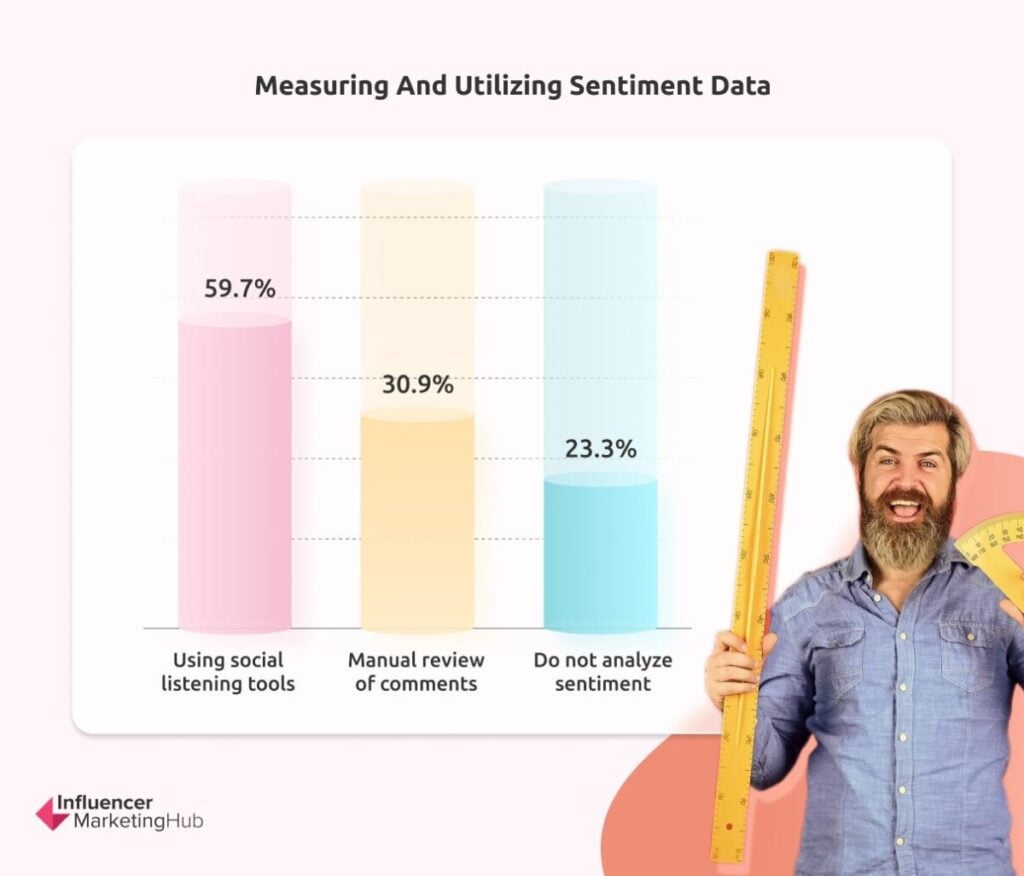
- Utilizing social listening instruments: 59.7%
- Handbook overview of feedback: 30.9%
- Don’t analyze sentiment: 23.3%
Comparative Insights with July Findings
In July, a powerful focus was additionally positioned on qualitative metrics, with manufacturers more and more utilizing sentiment evaluation to gauge marketing campaign effectiveness. The reliance on digital footprints and direct buyer suggestions has grown, reflecting a classy strategy to understanding model notion.
- Emphasis on Emotional Metrics: The rising use of social listening instruments signifies a shift in direction of real-time, data-driven methods that may promptly tackle shopper suggestions and optimize content material.
- Missed Alternatives: With 23.3% of manufacturers not analyzing emotional sentiment, there stays a big hole in leveraging information that would present deeper insights into buyer habits and engagement.
Effectiveness of Micro, Nano, and Macro Influencers
The October information reveals a big desire for nano-influencers, indicating their rising influence on advertising methods:
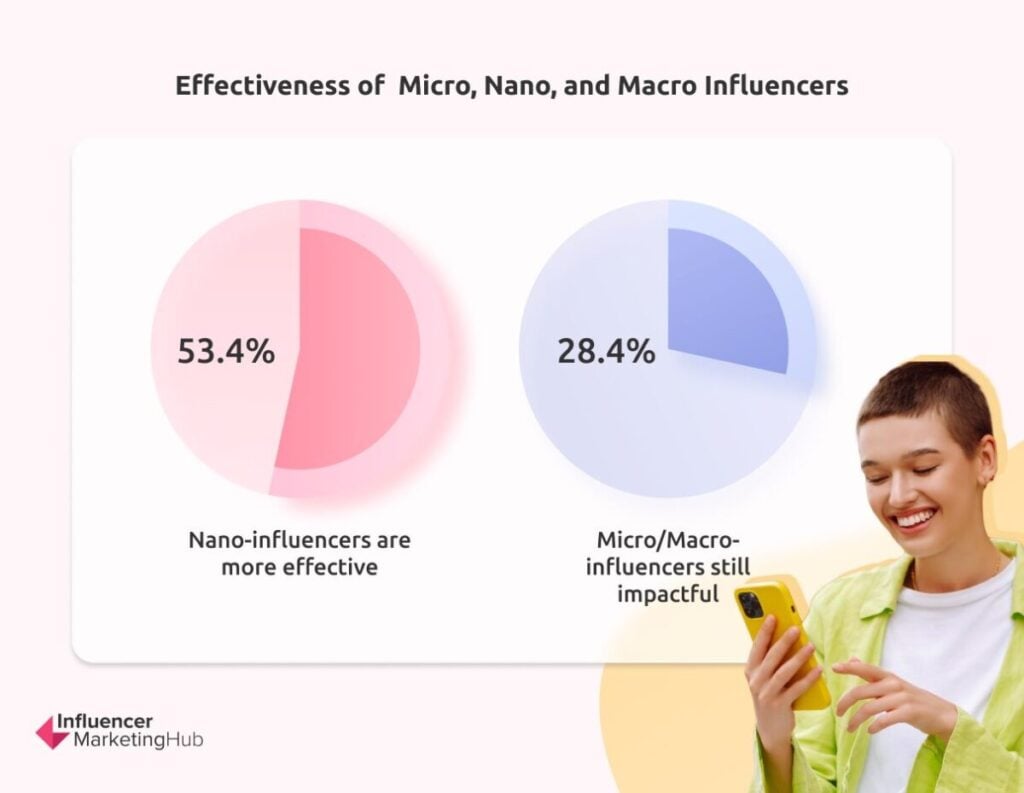
- Nano-influencers are more practical: 53.4%
- Micro/Macro-influencers nonetheless impactful: 28.4%
Developments from the July Report
The July report additionally famous a shift in direction of nano-influencers, with 43% of respondents rising their use of those smaller-scale influencers. This constant development factors to a broader motion throughout the business in direction of extra genuine and relatable influencer partnerships.
- Rise of Nano-Influencers: The desire for nano-influencers is pushed by their perceived authenticity and stronger engagement charges, making them beneficial property in fostering belief and constructing real connections.
- Strategic Finances Reallocation: Entrepreneurs are reallocating their budgets from macro to nano-influencers, reflecting a concentrate on attaining increased ROI via customized interactions with area of interest audiences.
AI Integration in Influencer Advertising
AI’s position in enhancing influencer advertising methods stays a sizzling subject, with assorted sentiments noticed within the October information:
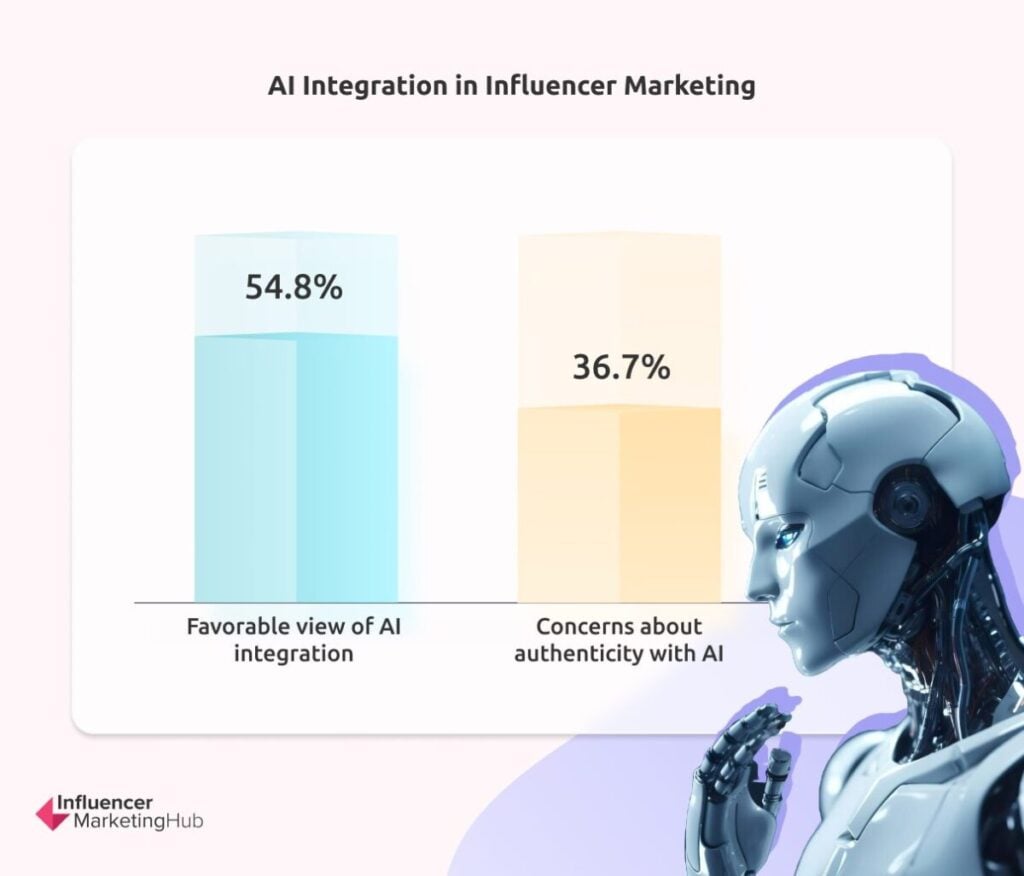
- Favorable view of AI integration: 54.8%
- Considerations about authenticity with AI: 36.7%
Evolution from July Information
In July, AI’s potential to streamline operations and enhance marketing campaign efficiency was well known. Nonetheless, the considerations concerning AI’s influence on authenticity stay constant, highlighting an ongoing debate throughout the business.
- AI as a Double-Edged Sword: Whereas AI instruments are celebrated for his or her effectivity in influencer identification and content material optimization, the problem lies in balancing expertise with the necessity for real, human-centric engagement.
- Future Improvements: The continued growth of AI options like TikTok’s Symphony is predicted to reshape the panorama, permitting for customized and scalable influencer campaigns that don’t compromise on authenticity.
Managing Adverse Sentiment in Influencer Campaigns
Addressing destructive sentiment is an important side of sustaining model status. The October survey findings point out the next approaches:
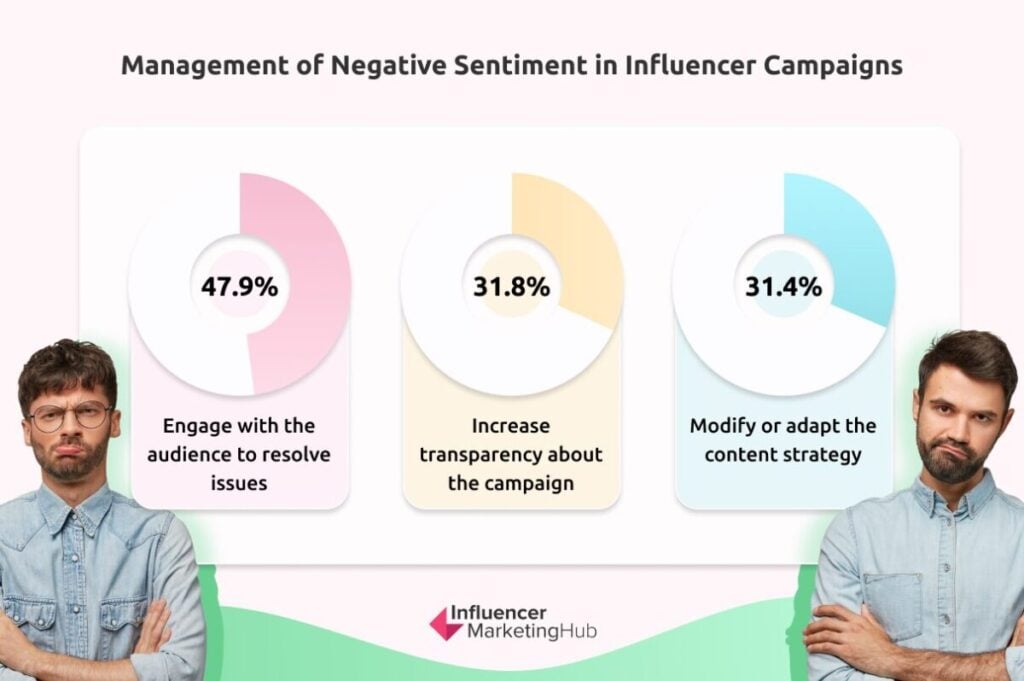
- Interact with the viewers to resolve points: 47.9%
- Enhance transparency concerning the marketing campaign: 31.8%
- Modify or adapt the content material technique: 31.4%
This constant emphasis on viewers engagement and transparency highlights a proactive strategy in direction of dealing with destructive suggestions, aligning with the business’s concentrate on authenticity and belief.
- Proactive Engagement: Manufacturers that actively interact with destructive sentiment usually tend to retain shopper belief and switch criticism into alternatives for development.
- Transparency as a Technique: Growing transparency about marketing campaign processes and influencer partnerships can mitigate backlash and foster deeper connections with the viewers.
Influencer Fatigue and Shopper Belief
With the rise of influencer advertising, the business is starting to expertise indicators of fatigue:
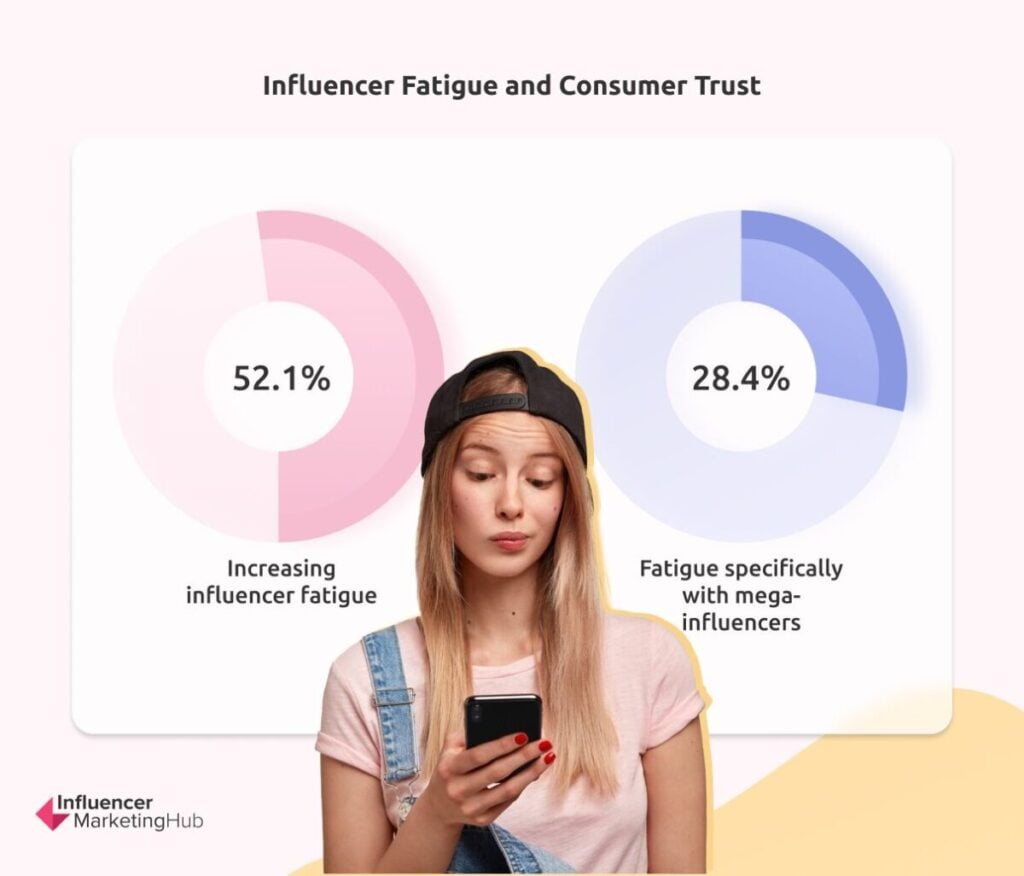
- Growing influencer fatigue: 52.1%
- Fatigue particularly with mega-influencers: 28.4%
Insights from the July Report
July’s findings additionally pointed in direction of a saturation of conventional influencer content material, emphasizing the necessity for contemporary methods to take care of viewers engagement.
- Combatting Influencer Fatigue: Entrepreneurs should innovate by specializing in authenticity, leveraging micro and nano-influencers, and incorporating user-generated content material to maintain the viewers engaged.
- Shift from Mega-Influencers: The declining effectiveness of mega-influencers highlights a transfer in direction of extra customized advertising approaches that resonate on a deeper degree with shoppers.
Shoppable Content material and E-Commerce Integration
Shoppable content material continues to achieve traction, driving direct conversions from influencer-driven campaigns:
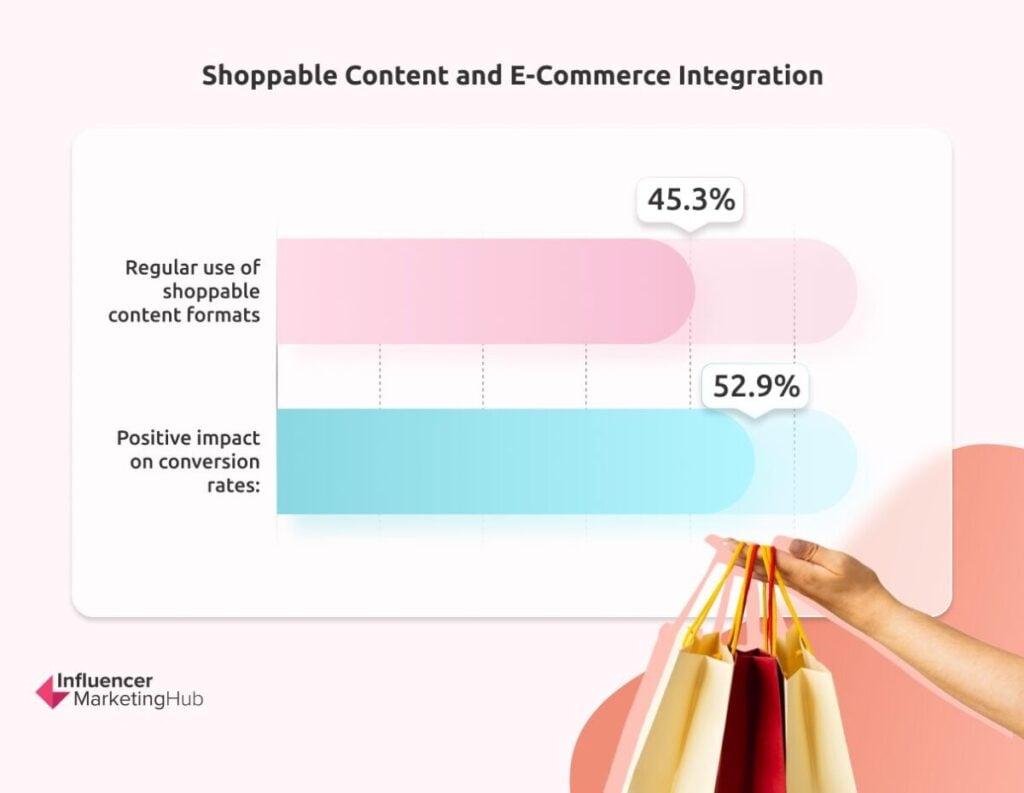
- Common use of shoppable content material codecs: 45.3%
- Constructive influence on conversion charges: 52.9%
Comparative Analysis with July Developments
In July, the adoption of shoppable content material codecs like Instagram Checkout and TikTok Purchasing was famous as a rising development, emphasizing their position in streamlining the shopper journey.
- Seamless Purchasing Experiences: Shoppable content material reduces friction within the buyer journey, enhancing each consumer expertise and conversion charges.
- Future Potential: As extra manufacturers undertake these codecs, the power to trace influencer-driven gross sales and enhance ROI will change into more and more refined and efficient.
Generational Focusing on in Influencer Campaigns
Focusing on the proper generational viewers is a strategic focus in influencer advertising:
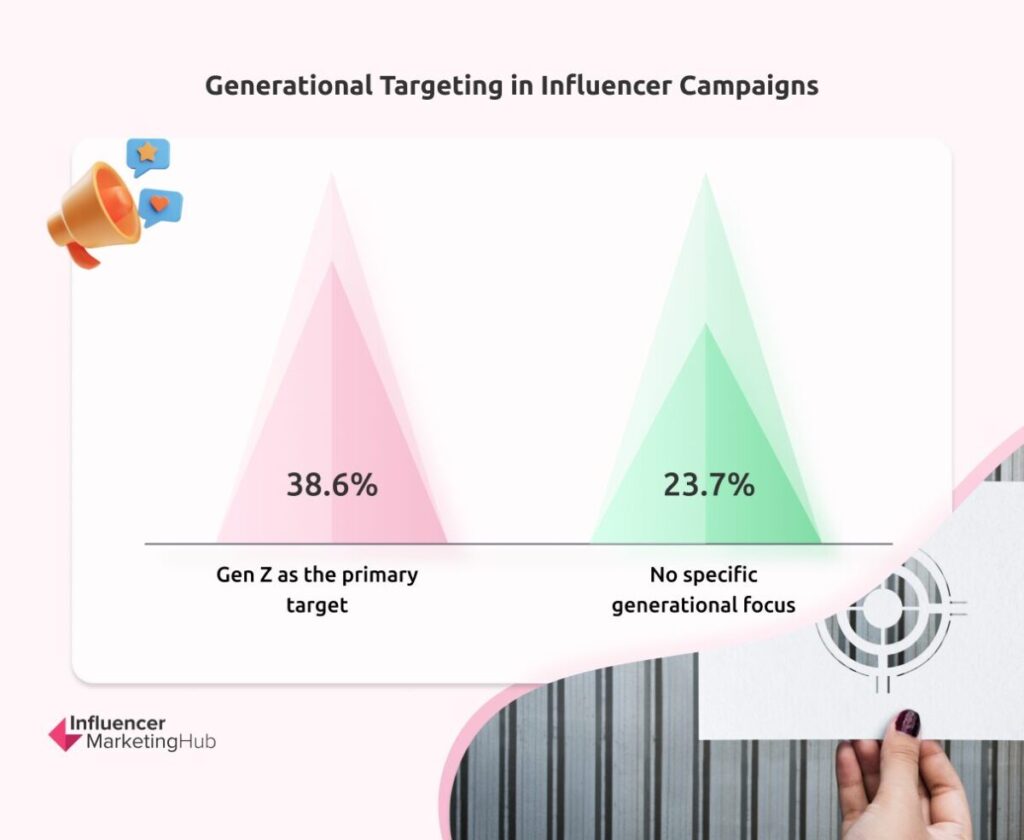
- Gen Z as the first goal: 38.6%
- No particular generational focus: 23.7%
Consistency with Prior Information
The emphasis on Gen Z continues to dominate advertising methods, reflecting their vital presence on platforms like TikTok and Instagram.
- Gen Z Dominance: Manufacturers specializing in Gen Z are tapping right into a demographic that values authenticity, social influence, and technology-driven engagement.
- Diversification Wants: Whereas Gen Z stays essential, manufacturers mustn’t ignore alternatives to succeed in Millennials and Gen X via platform-specific methods that cater to their preferences.
Strategic Timing and Platform Effectiveness
Timing is crucial in maximizing influencer marketing campaign engagement, with the survey revealing that:
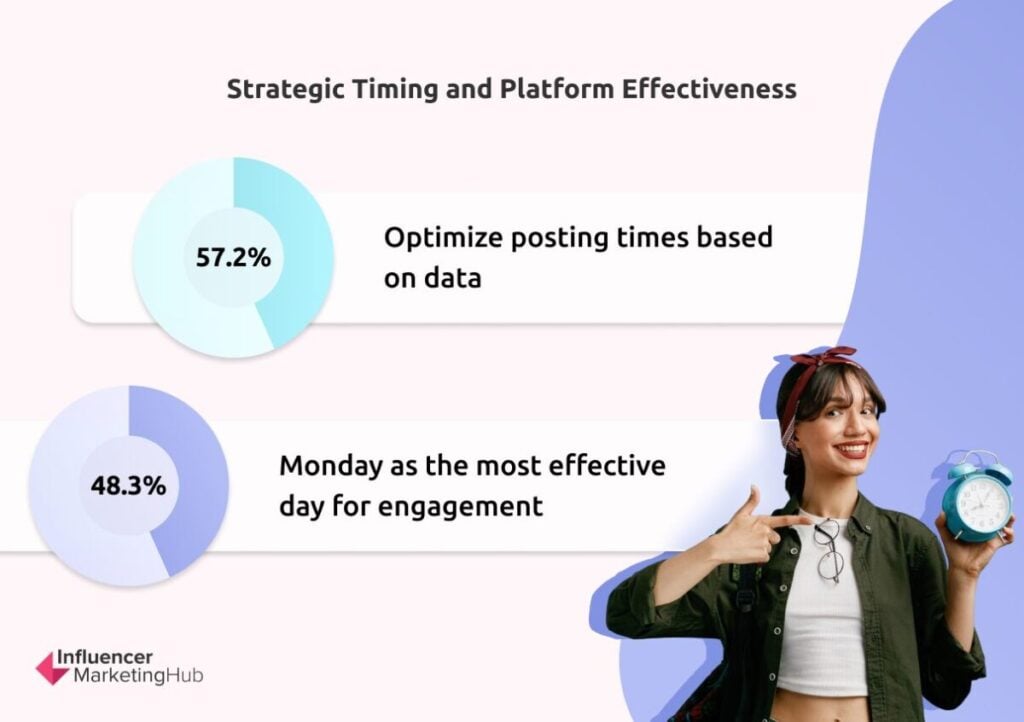
- Optimize posting instances primarily based on information: 57.2%
- Monday as the best day for engagement: 48.3%
Evolution from July Information
The strategic timing of campaigns, as noticed in earlier reviews, aligns with viewers habits patterns, making certain content material reaches its peak visibility.
- Information-Pushed Choices: Leveraging information to time marketing campaign releases ensures that manufacturers maximize engagement throughout peak exercise intervals.
- Refinement Alternatives: Continuous evaluation of viewers habits will assist manufacturers refine their methods, resulting in increased engagement and improved ROI.
The Path Ahead: Challenges and Alternatives
The October 2024 survey gives a transparent image of the place influencer advertising is headed. Because the panorama grows extra subtle, challenges akin to influencer fatigue, destructive sentiment administration, and sustaining authenticity amidst AI developments will form future methods.
Key Challenges:
- Fragmented Consideration: With shoppers dealing with info overload, capturing consideration via significant, genuine content material is extra necessary than ever.
- Balancing AI and Human Connection: The position of AI in influencer advertising is pivotal, but manufacturers should be certain that expertise enhances moderately than detracts from real viewers engagement.
Alternatives:
- Leveraging Micro and Nano-Influencers: The shift in direction of smaller influencers presents a chance to foster deeper connections with area of interest audiences.
- Revolutionary Content material Codecs: Using dynamic content material codecs like TikTok Purchasing and Instagram Reels may also help manufacturers differentiate themselves and drive increased engagement.
The Closing Phrase: Influencer Advertising Is No Longer a Technique—It’s a Actuality Test
Let’s get actual. If you happen to’re nonetheless treating influencer advertising as a shiny add-on to your model technique, you’re about to be left within the mud. The panorama of influencer advertising has dramatically shifted, and our October 2024 report doesn’t simply define the modifications—it screams them. We’ve moved from an period of mega-influencers and hole follower counts to a world the place belief, authenticity, and strategic precision aren’t simply beneficial—they’re important.
This report highlights a transparent, data-backed actuality: influencer advertising is present process a disruptive evolution, pushed by the rise of nano-influencers, AI integration, and the strategic shift in direction of thought management in B2B. Manufacturers that embrace these modifications will thrive; people who don’t will battle to stay related.
Tangible, Actionable Insights for Entrepreneurs Who Refuse to Be Common:
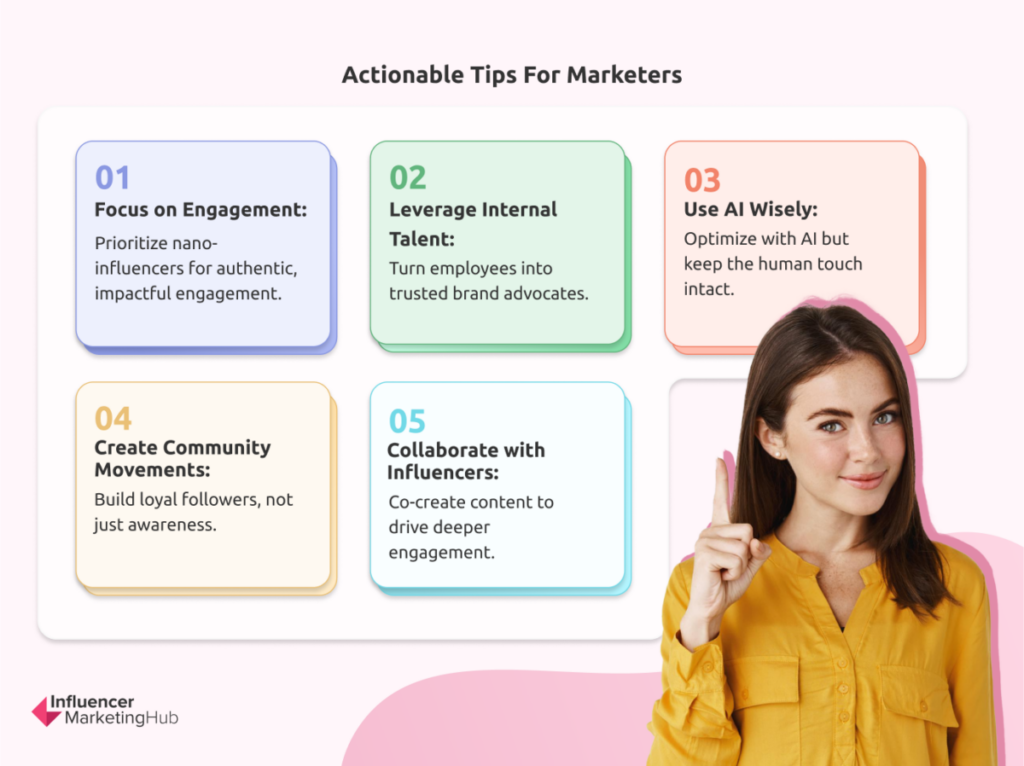
1. Transfer Past the Follower Rely Obsession:
Cease chasing self-importance metrics. The info reveals that 53.4% of entrepreneurs are actually shifting their focus in direction of nano-influencers as a result of they ship engagement that’s genuine, direct, and genuinely impactful. Give it some thought: would you moderately have a star shoutout to 1,000,000 passive listeners or a revered business voice whispering instantly into the ears of decision-makers who cling on each phrase? Prioritize affect, not attain.
2. Construct Your Personal Influencers from Inside:
Take a web page out of IBM’s playbook. They didn’t simply accomplice with exterior influencers; they turned their very own staff into model evangelists via structured packages and recognition programs just like the “IBM Influencer” badge. Inside specialists who’re empowered to talk on behalf of your model will at all times carry extra credibility. If you happen to’re not already turning your crew into your most genuine influencers, you’re lacking out on one of the potent trust-building methods.
3. AI is Your Wingman, Not Your Substitute:
Let’s face it, AI in influencer advertising could be a double-edged sword. Our survey information reveals 54.8% of entrepreneurs are utilizing AI to reinforce effectivity, however they’re additionally cautious of shedding that human contact. The trick isn’t simply in accumulating information—it’s in turning that information into relatable, human-centric experiences that resonate on a deep degree. Use AI to streamline and optimize however by no means at the price of sacrificing your model’s authenticity. Consider AI as your technique assistant, not the face of your marketing campaign.
4. The Politics of Affect: Be taught from the Finest
Political campaigns have nailed what most Fortune 500 manufacturers are nonetheless struggling to know. They don’t simply use influencers; they weaponize them. It’s not about flashy adverts; it’s about creating actions, sparking conversations, and mobilizing communities. In case your model isn’t considering of influencer advertising as a strategy to construct not simply consciousness however a loyal tribe of advocates, you then’re taking part in checkers in a chess world. Be daring sufficient to remodel your influencer advertising right into a neighborhood motion.
5. Double Down on Thought Management and Content material Co-Creation:
Collaboration is your strongest device in B2B influencer advertising. Have a look at Microsoft’s MVP Program—they didn’t simply ask for endorsements; they co-created product content material with their influencers. This strategy has amplified Microsoft’s management in cloud and AI. The end result? Engaged audiences and sooner adoption charges. Entrepreneurs, take word: contain your influencers in content material creation from the bottom up—make them stakeholders, not simply spokespeople.
If you wish to keep forward, it’s time to rethink your influencer playbook from the bottom up.
Innovate your strategy by embracing thought management. Combine AI to supercharge your campaigns with out shedding that all-important human connection. And above all, purpose to affect not simply via content material however via significant, genuine interactions that create true model advocates.
To the entrepreneurs on the market who nonetheless imagine that influencer advertising is only a field to verify—right here’s your wake-up name. Adapt, evolve, and above all, be daring. As a result of on this sport, in the event you’re not influencing change, you’re simply following it.



